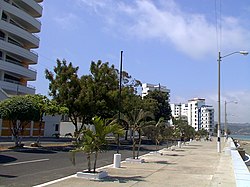Bahía de Caráquez
| Bahía de Caráquez | |
|---|---|
| City | |
| La Villa de San Antonio de Caráquez | |
 |
|
| Coordinates: 0°36′0″S 80°25′0″W / 0.60000°S 80.41667°WCoordinates: 0°36′0″S 80°25′0″W / 0.60000°S 80.41667°W | |
| Country | Ecuador |
| Province | Manabí |
| Canton | Sucre |
| Founded | March 1624 |
| Founded by | José de Larrazábal |
| Government | |
| • Mayor | Manuel Gilces Mero |
| Population | |
| • Total | 19,703 |
| Time zone | ECT (UTC-5) |
| Climate | BSh |
| Website | www.bahiadecaraquez.com |
Bahía de Caráquez, officially known as San Antonio de Caraquez and founded under the name of Villa de San Antonio de la Bahía de Caráquez or simply known today as Bahía, formerly called Bahía de los Caras during the period of the Spanish conquest, is a coastal city belonging to the Sucre county, in the Ecuadorian province of Manabí. The city is located on a sandy peninsula on the country's western coast at the mouth of the Río Chone and has considerable tourism infrastructure that positions it as the main regional town. It has seen significant development during the last 15 to 20 years, particularly because it has become a vacation destination for people from Quito and Guayaquil. The city is located one hour north of the city of Manta and in the pre-Columbian era was host to the ancient Indian city of Caran. Across the bay is the town of San Vicente.
Bahía became an Ecocity on February 23, 1999 due to the devastation caused by two natural disasters in 1997 and 1998. The city features the world's first certified-organic shrimp farm.
Across the Rio Chone is the city of San Vicente. Locals cross the river by bridge and boat. The bridge was completed as of November 2010.
Bahia differs greatly from the neighboring San Vicente. Featuring great condominia and hotels the city is a popular tourist destination for the wealthy.
The city also boasts a well-known archeological museum, which displays artifacts found in Manabi from very different periods. The collection includes statues from the Valdivia culture as well as several other lesser-known historical communities.
The city was founded on the sea, settled permanently in the current bay in March 1628 with the official name of Villa de San Antonio de la Bahía de Caráquez by Jose de Larrazabal during the reign of Philip IV of Spain, by order of the President of the Royal Audience of Quito, Doctor Antonio de Morga.
...
Wikipedia
